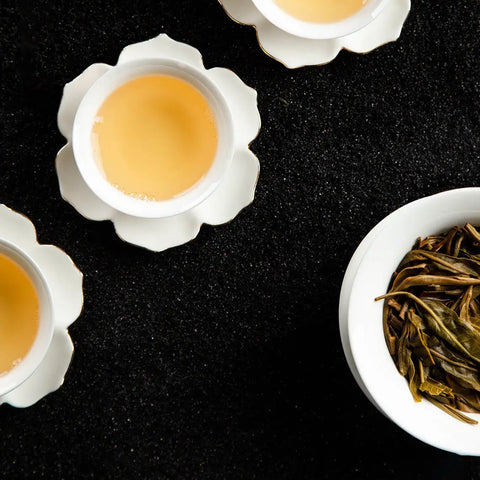When to Drink Pu-erh Tea for Weight Loss
Pu-erh tea originates from a specific region in China and offers unique compounds believed to aid in weight loss.
Origins and Types
Pu-erh tea comes from Yunnan province, China. It is named after the city Pu'er, famous for trading tea. There are two main types: raw (sheng) and ripe (shou).
Raw Pu-erh is naturally fermented and aged, sometimes for many years. Ripe Pu-erh undergoes an accelerated fermentation process. These types differ in taste, with raw Pu-erh having a more robust flavor and ripe Pu-erh being smoother.
Bestsellers
Active Components and Weight Loss Properties
Pu-erh tea contains catechins, caffeine, and theanine. These compounds boost metabolism and aid in fat breakdown. Catechins are antioxidants that support fat oxidation. Caffeine increases energy expenditure, enhancing calorie burning.
Fermented Pu-erh tea has unique microbes and enzymes thought to improve digestion and decrease fat absorption. You benefit from these active components when consuming Pu-erh tea in moderation as part of a balanced diet.
Best Practices for Drinking Pu-erh Tea

To maximize the benefits of pu-erh tea for weight loss, consider the timing of your consumption and the appropriate dosage.
Optimal Timing for Consumption
Drinking pu-erh tea in the morning can help boost metabolism. A cup after breakfast may enhance digestion and energy levels throughout the day. You might also drink pu-erh tea 30 minutes after meals to aid in fat digestion. Having it right after meals is discouraged as it might interfere with nutrient absorption.
Avoid drinking pu-erh tea late in the evening to prevent potential sleep disturbances due to its caffeine content. Instead, choose to consume it during the day to benefit from its energy-boosting properties without affecting your sleep patterns.
Recommended Dosage
Start with smaller amounts, such as one cup per day, if you are new to pu-erh tea. Gradually increase to two or three cups daily as your body adjusts. Each cup should be equivalent to about one teaspoon of loose-leaf pu-erh tea per 8 ounces of water.
Overconsumption can lead to side effects such as digestive discomfort or caffeine-related issues. Consistent, moderate intake is more likely to yield weight loss benefits without adverse effects. Make sure to brew the tea properly to ensure you are getting the full range of benefits.
Preparation of Pu-erh Te
Proper preparation of Pu-erh tea is crucial for maximizing its potential benefits. This includes carefully selecting the brewing technique and ensuring the correct serving temperature to enhance flavor and efficacy.
Brewing Techniques
The traditional method of brewing Pu-erh tea involves rinsing the leaves briefly with hot water. This step helps to remove impurities and awaken the tea leaves. After rinsing, steep the leaves in hot water for about 3-5 minutes.
For optimal results, use between 1-2 teaspoons of loose leaf Pu-erh tea per cup. Adjust the amount based on your preference for strength. You can use a teapot, gaiwan, or even a French press. Consistent water temperature and steeping times ensure the best flavor.
Serving Temperature
Serve Pu-erh tea at a temperature between 85-95°C (185-203°F). This range is ideal for preserving the tea's unique flavors without making it overly bitter. Using a thermometer can help in maintaining accuracy.
Lao Ban Zhang
Once brewed, pour the tea immediately to avoid over-steeping, which can lead to a harsh taste. Allow it to cool slightly before drinking, but not too much, because the warm temperature aids in digestion and improves the overall experience.
Integrating Pu-erh Tea into Your Diet

Drinking Pu-erh tea at specific times can promote weight loss and help you avoid dietary pitfalls.
Complementing Meals with Pu-erh Tea
Drinking Pu-erh tea after meals can aid in digestion. The tea's active compounds help accelerate the digestive process, ensuring food is broken down efficiently.
Have a cup about 30 minutes after eating to stimulate metabolism. This practice can prevent fat accumulation and help manage weight effectively.
Pairing Pu-erh tea with high-fiber foods can boost its efficacy. High-fiber foods and Pu-erh work together to enhance digestion and nutrient absorption. Add this habit to your routine for better results.
Avoiding Unhealthy Combinations
Certain combinations can reduce the benefits of Pu-erh tea. Avoid drinking Pu-erh with sugary snacks. The high sugar content can counterbalance the tea's ability to manage blood sugar levels.
Avoid dairy products with Pu-erh tea. The proteins in dairy may interfere with the tea's beneficial compounds. Instead, opt for plant-based options.
Caffeine-sensitive individuals should avoid late-night consumption to prevent sleep disturbances. Be mindful of when you drink it to ensure your body's restful sleep cycle.
Scientific Studies on Pu-erh Tea and Weight Loss
Various scientific studies have investigated the potential benefits of pu-erh tea for weight loss. Researchers have focused on its unique fermentation process and specific compounds.
Antioxidants and Polyphenols
Pu-erh tea is rich in antioxidants and polyphenols. These compounds are believed to help in fat metabolism. A study published in Phytotherapy Research found that polyphenols in pu-erh tea can reduce body weight and improve serum lipid profiles.
Fermentation Process
The unique fermentation of pu-erh tea creates biologically active compounds. These compounds may enhance the tea’s weight loss properties. A study in the Journal of Agricultural and Food Chemistry showed that fermented pu-erh tea has greater fat-reducing effects compared to unfermented tea.
Animal Studies
Several animal studies suggest pu-erh tea can reduce fat accumulation. One such study in Nutrition Research indicated that rats fed a high-fat diet supplemented with pu-erh tea extract gained less weight.
Human Studies
Human studies confirm some of the findings from animal research. A clinical trial reported in The American Journal of Clinical Nutrition found that participants who consumed pu-erh tea daily experienced significant weight reduction and decreased waist circumference.
Possible Mechanisms
Possible mechanisms for pu-erh tea’s weight loss effects include:
- Increased fat breakdown
- Enhanced fat oxidation
- Improved gut health
Summary of Findings
| Study Type | Findings |
|---|---|
| Animal | Reduction in fat accumulation in high-fat diet rats |
| Human | Significant weight loss and reduced waist circumference |
These studies suggest that consuming pu-erh tea may aid weight loss by affecting metabolic processes and fat metabolism.
Potential Side Effects and Considerations

Drinking pu-erh tea for weight loss can be effective, yet it's important to be aware of potential side effects and interactions, especially related to caffeine and medications.
Monitoring Caffeine Intake
Pu-erh tea contains caffeine, which can affect your sleep patterns and may contribute to anxiety or jitteriness if consumed in large quantities.
Caffeine sensitivity varies from person to person. Excessive consumption can cause headaches, increased heart rate, and digestive issues.
To reduce these risks, limit your pu-erh tea intake to 1-2 cups per day, especially if you're sensitive to caffeine. Drinking it earlier in the day can further minimize sleep disturbances.
Interactions with Medications
Pu-erh tea can interact with certain medications, affecting their efficacy or causing adverse effects.
If you take medications for blood pressure, heart conditions, or diabetes, consult your doctor before adding pu-erh tea to your regimen.
The tea's caffeine content may interfere with medications, intensifying side effects such as increased heart rate or blood pressure. Additionally, compounds in pu-erh tea might alter the absorption of some drugs.
Stay informed about how your medicines and pu-erh tea might interact to maintain your health and ensure effective treatment.
Personalizing Your Pu-erh Tea Experience

Customizing your Pu-erh tea regimen can optimize its benefits based on personal needs and preferences. Key areas include adjustments for individual metabolism and exploring different Pu-erh variants.
Adjustments for Individual Metabolism
Every person’s metabolism reacts differently to Pu-erh tea. Factors like age, weight, and lifestyle can influence how effectively it supports weight loss. You may need to experiment with timing, such as drinking it before meals to curb appetite or after meals to aid digestion. Additionally, matching your tea consumption with your daily activity level can maximize results without causing digestive issues.
Exploring Different Pu-erh Variants
Pu-erh tea comes in various forms like raw (sheng) or ripe (shou). Raw Pu-erh is less processed and can have a stronger, more complex flavor profile, while ripe Pu-erh is aged and mellower. Trying different variants can help you discover which type suits your taste and metabolism best. You can also adjust the brewing time and temperature to highlight different flavors and benefits.
← Older post Newer post →











